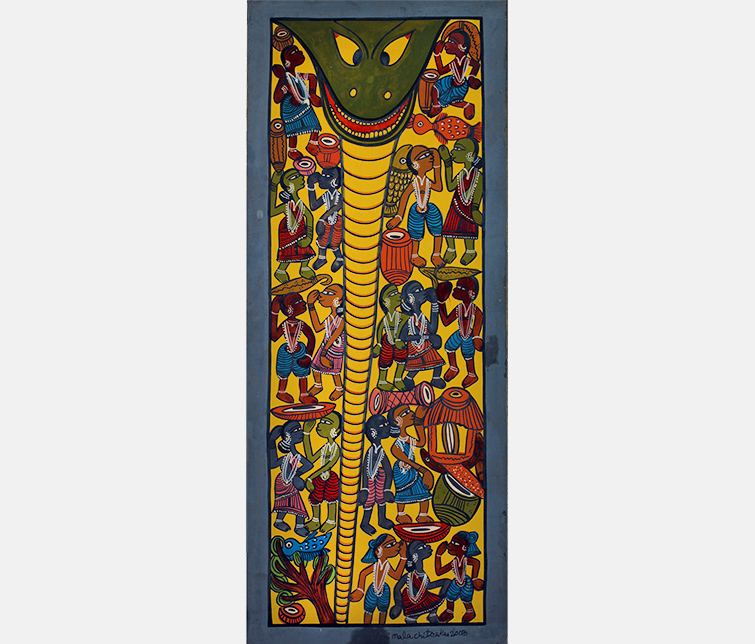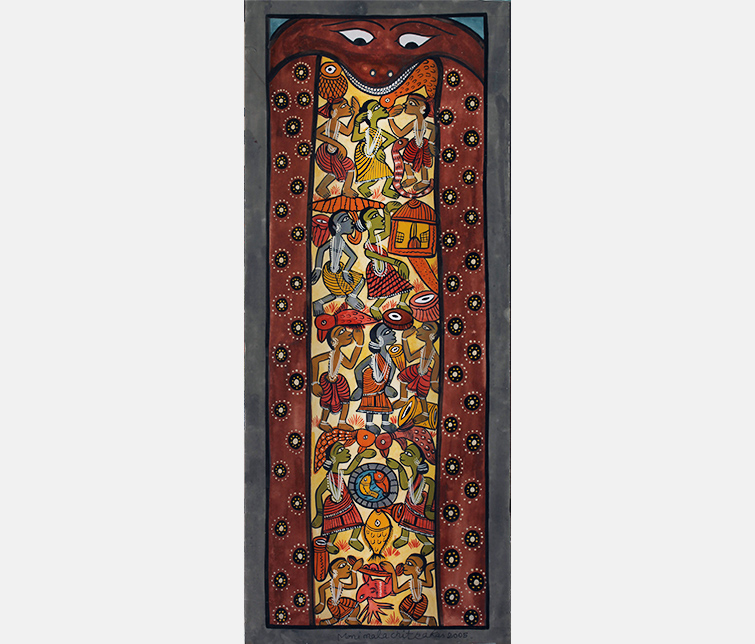
Bengal Patua painting by Manimala Chitrakar © Sarmaya Arts Foundation
“Monimala paints worlds that are divine and primitive, tender and cruel. On long rolls of paper, memory retains the power of expression, festive exuberance and graphical freedom of the universe that she describes in a ritual manner every evening, in the limited and darkened space of her hut… Her works are the means by which she relates her life, in which her iconography blends together in a dizzying, drunken swirl. She paints sex. She paints violence. She sings the stories of the gods.”
Art curator Hervé Perdriolle in his book, Indian Contemporary Art: Contemporary, One Word, Several Worlds
Manimala—also spelt Monimala—spent her childhood following her grandfather Dukushyam Chitrakar as he performed with his paintings in and around their village of Naya in Bengal’s Medinipur district. From him, Manimala learnt how to be an all-in-one artist. Bengal Pattachitra or Patua is one of those rare art forms like the Tholu Bommalaata, whose artists aka chitrakars are also storytellers, music composers, lyricists and singers.
The paater gaan or song that accompanies the Patua is half the piece of the puzzle, the painting and performance are the other half. Chitrakars travel with these scrolls from house to house, and when they find a patron, they squat in their yard, unroll the painting one register at a time and lead them through the plot through song. The audience is usually small and the setting is intimate. No instruments accompany the singer. Just their clear, lilting voice rising and falling with the turns in the plotline.

Bengal Pattachitra by Manimala Chitrakar © Sarmaya Arts Foundation
Her singing voice may be sweet but Manimala’s visual art is visceral. Unbridled power courses through the sinuous length of her typically long canvas. The artist brings a strong point of view to her compositions, whether it’s the Santhal legend of creation or tales from the Ramayana. Using sure, bold black outlines, Manimala creates a style that’s forceful and energetic—there are no ambiguities here. This makes her art especially versatile when it comes to framing contemporary ideas. Like many other chitrakars, Manimala weaves into her paintings messages relating to social justice, the environment and health. She has addressed the fallout of the Indian Ocean tsunami, the AIDS epidemic and aspects of women’s reproductive health through her work.
Manimala’s art has been shown in India and abroad as part of exhibitions that celebrate the innovations and the diversity of creative expressions among indigenous art, including the 2011 show ‘Vernacular in the Contemporary’, curated by Annapurna Garimella. It was also part of ‘The 8th Asia-Pacific Triennial of Contemporary Art’ in 2016 in Queensland, which focused on performance as an integral part of modern art. Despite the fact that Patua paintings are categorised as ‘folk’, there isn’t really any compelling reason to exclude artists like Manimala Chitrakar from being counted among contemporary Indian artists. Her work is every bit as vital, provocative and engaging.
Manimala Chitrakar was one of the five artists whose Wikipedia profiles we edited as part of Sarmaya’s event for Art+Feminism 2019. Visit Manimala Chitrakar’s Wiki page by clicking here



